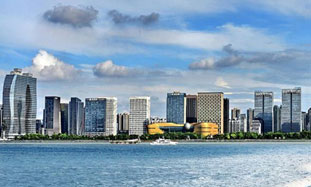Design by commitment

The Xiangshan campus of the China Academy of Art in Hangzhou and a library in Suzhou University are among architect Wang Shu's representative works. [Photo provided to China Daily]
"Cultural diversity is a beautiful aspect of the world, and it's also important to enhance the mutual understanding among people from different countries, generations and ethnic groups, which can help us see the wider world. I hope our forum will manage this, and lead to the next step of win-win cooperation."
It was also when a group of renowned architects from both China and France shared their common ideas about what constitutes harmonious architecture, and the relationship between buildings and their natural surroundings and the cultural tradition of their homelands.
For Wang, the Silk Road is the embodiment of cultural diversity. Growing up in a number of cities including Urumqi, Xi'an and Beijing, while living and studying in a range of buildings made of adobe, brick and other materials, he learned that architecture doesn't have to adhere to one particular cultural standard.
Although he has courted controversy through his work, often doubting the impracticability of his designs, Wang, for years, has been promoting the idea of integrated architecture with its surroundings, and exploring new ways to combine the language of modern architecture with the traditional Chinese one to create a new architectural field.
One of his representative works is the Xiangshan campus at the China Academy of Art in Hangzhou, Zhejiang province, built between 2002 and 2007 using more than 7 million pieces of recycled bricks, tiles and stones, with around 30 buildings set in a recreated natural landscape. It evokes a strong sense of a traditional Chinese garden set within a rural idyll.
He further realized this idea in his designs for museums in Ningbo and Fuyang in Zhejiang, where traditional villages have largely been torn down. There he turned his focus to tackle rural revitalization through his architectural designs, a growing trend in China these days.
French architect Paul Andreu, 80, designer of the Charles de Gaulle Airport in Paris, Pudong International Airport in Shanghai and the National Center for the Performing Arts in Beijing, says he was impressed by the rural architectural work designed by the new generation of young Chinese architects that were exhibited at this year's Venice Biennale of Architecture.

 Print
Print Mail
Mail
 20 Cultural Symbols
20 Cultural Symbols Why Zhejiang
Why Zhejiang Experiencing high-tech products at WIC
Experiencing high-tech products at WIC Zhejiang Release
Zhejiang Release Zhejiang News
Zhejiang News